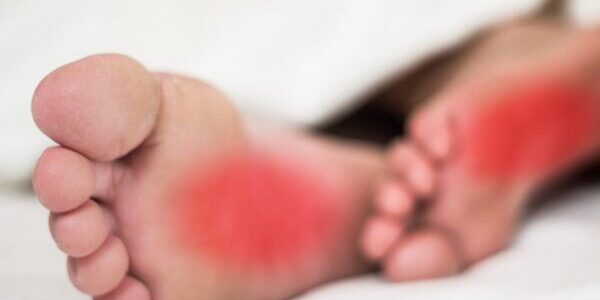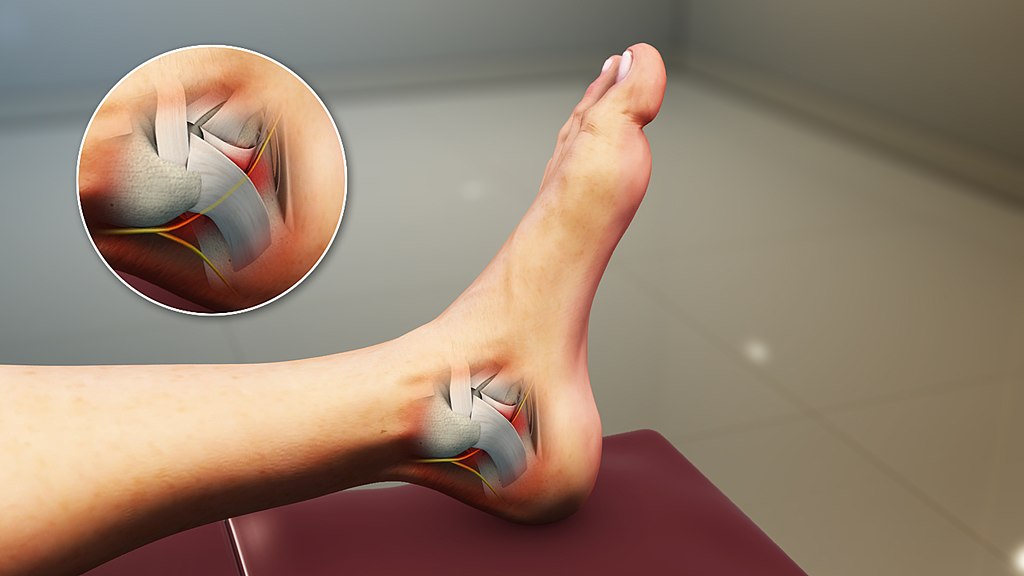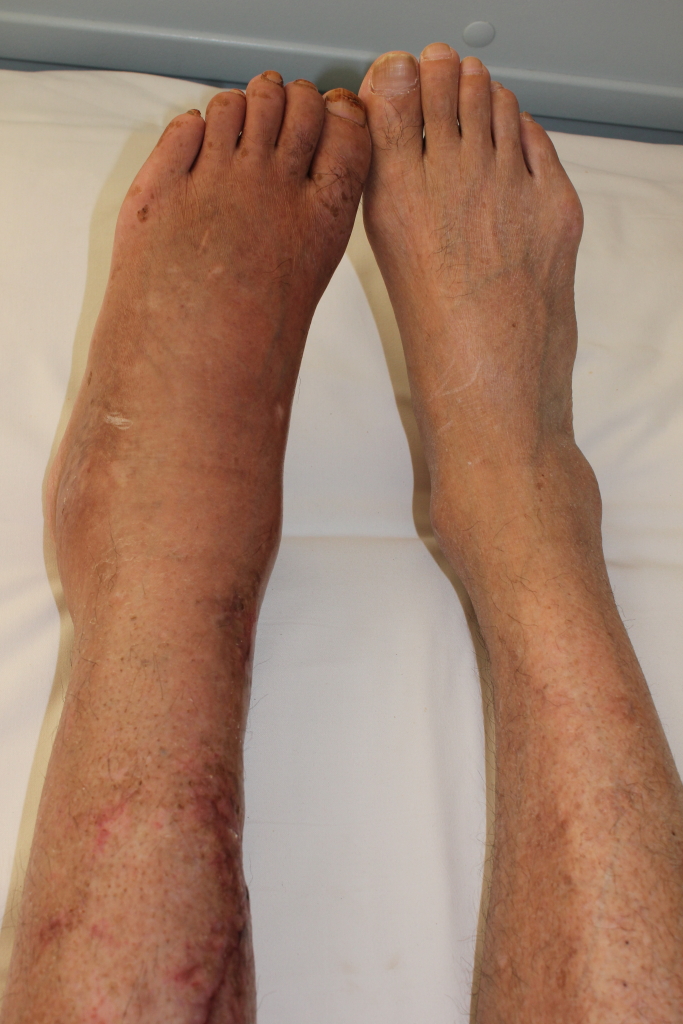Do you feel a burning sensation in your feet at night? Does the burning pain give you long, uncomfortable days and sleepless, agonising nights?
You could be suffering from burning feet syndrome. This foot problem is characterised by a sensation of burning in the feet that can either be periodic or constant. Moreover, the level of pain can be mild during the day and severe during the night.
But why do your feet feel uncomfortably hot, especially at night?
In this post, we’ll share the different causes of burning feet syndrome that we see and help with here at Adelaide Foot and Ankle.
What causes burning feet?
Burning feet or Grierson-Gopalan Syndrome typically affects the elderly. Nevertheless, it can affect anyone for several reasons.
Whilst the common cause of burning feet syndrome is nerve damage that is often associated with diabetes, there are other causes. Hence, it’s essential to ascertain the cause to receive the appropriate treatment.
Some causes of burning feet can be due to wearing ill-fitting shoes or a fungal infection like athlete’s foot, which can be remedied at home. For burning feet with severe pain, it is necessary to seek help from your foot doctor or podiatrist to detect the underlying cause of your foot problem.
1.Foot Posture and Other Foot Problems
Foot posture can affect how your feet handle pressure every time you walk. Whilst your body weight is evenly distributed as you walk, certain arches of the foot can make you prone to experiencing localised pressure. Consequently, it can lead to redness and a burning sensation.
Considered the opposite of flat feet, high-arched feet are the most common example of bad foot posture that can lead to burning feet syndrome.
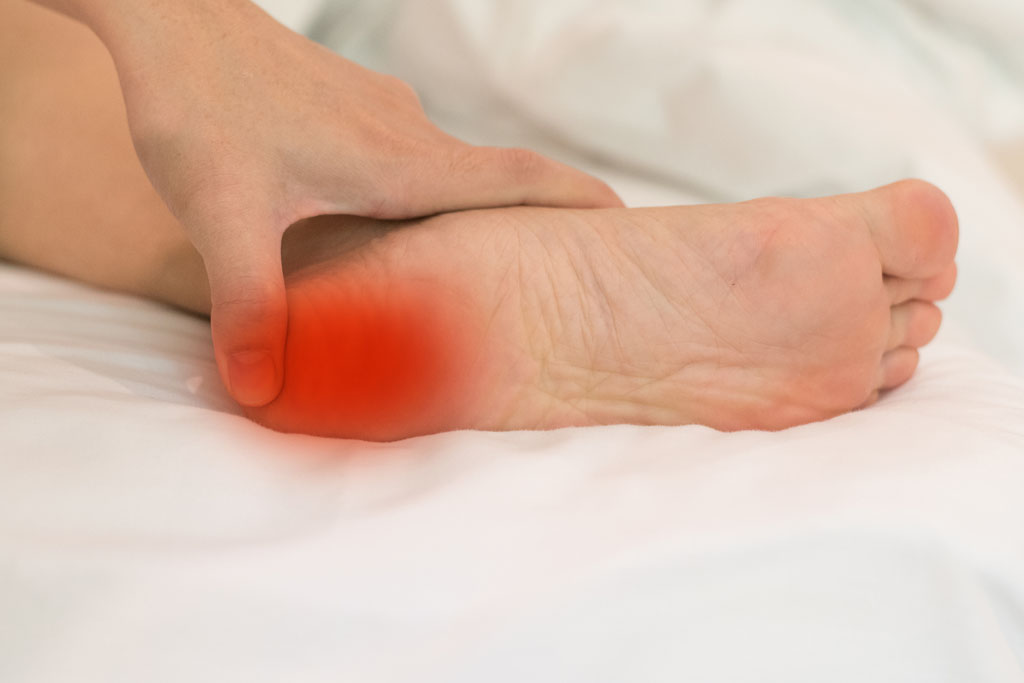
Heel Pain or plantar fasciitis concept. Hand on foot as suffer from inflammation feet problem of Sever’s Disease or calcaneal apophysitis.
For this type of foot arch, weight distribution is concentrated on the heel and the ball of the foot. These areas of the foot take an excessive amount of pressure when you’re walking or standing.
Likewise, walking can place tremendous pressure on other foot problems such as prominent swollen joints, warts, corns and calluses, which can potentially result in burning sensations.
2.Athlete’s Foot
Tinea pedis, more commonly known as Athlete’s foot, is a contagious fungal infection that produces a temporary burning sensation on the feet. This foot problem is caused by dermatophytes, mould-like fungi that thrive in the skin’s moist, warm areas. Humid environments such as damp shoes and socks allow the growth and spread of fungi.
If you have athlete’s foot, you may experience itching, stinging or burning sensation between the soles of the feet and between your toes.
Other symptoms of athlete’s foot include:
- Bubbly, blistery skin and redness
- Dry outer skin of your feet
- Cracking and skin peeling
- Discoloured, thick and crumbly toenails
The burning sensation you experience is due to the dermatophytes feeding on keratin, a type of fibrous protein found in our hair, nails and the outer layer of our skin. Fortunately, athlete’s foot can be treated with antifungal products and other home remedies.
3.Too much alcohol consumption
Drinking too much alcohol can put you at risk of alcoholic neuropathy, a type of nerve damage that can cause weakness, tingling and burning feet.
Other symptoms of alcoholic neuropathy include:
- Burning pain
- Hypersensitivity to pain
- Problems with gait
- Muscle weakness
Treatment for alcoholic neuropathy includes stopping alcohol use and eating a well-balanced diet. When following a balanced diet, make sure you’re getting the right nutrients, especially B vitamins.
4.Vitamin Deficiencies
According to a report, malnutrition can also cause a burning sensation in the feet. A deficiency of certain B vitamins can lead to the bottom of the foot burning at night. Additionally, it can cause problems with muscle coordination.
Older people who lack certain B vitamins (vitamin B-6, B-9 (folate) & B-12) in their diet are at risk of nerve damage.
Anemia caused by the lack of healthy red blood cells may also be caused by deficiencies in B vitamins. Common symptoms of vitamin deficiency anemia are shortness of breath, dizziness and fatigue.
5.Diabetic Peripheral Neuropathy
Peripheral neuropathy is one of the common symptoms of diabetes that causes numbness, weakness and short bursts of pain. It often occurs in the hands and feet. Diabetic peripheral neuropathy is the result of nerve damage in the brain and spinal cord.
You are more likely to develop this type of peripheral neuropathy if you have had diabetes for a long time. You can also develop diabetic neuropathy if you haven’t been controlling your blood glucose levels for several years.
According to a report, lower limb nerve damage affects around 13% of Australians with diabetes. Elevated blood sugar levels that are uncontrolled over a prolonged period can lead to peripheral nerve damage or diabetic neuropathy.
Treatment for diabetic neuropathy includes:
- Reducing pain using anti-seizure drugs and antidepressants
- Slowing down the disease from progressing and
- Managing complications (e.g., low blood pressure, digestive and urinary tract problems)
6.Small Fiber Neuropathy
Small fiber neuropathy (small fibre neuropathy) is another type of peripheral neuropathy that involves nerve damage leading to burning feet syndrome. It is often the result of a damaged myelin sheath, a protective covering of the peripheral nerves.
When the myelin sheath weakens, it slows down the transmission of electrical impulses. This creates changes to the sensations in the feet. Further, the ongoing nerve damage can turn a burning feet sensation into a numbing sensation over time.
The most common symptom of small fibre neuropathy is nerve pain. The other symptoms are:
- Headache
- Fatigue
- Bone & muscle pain and
- Problems with thinking & concentrating
Risk factors of small fibre neuropathy include:
- Hereditary features
- Toxin exposure such as alcohol and certain vaccines
- HIV, hepatitis C, Lyme disease and other infectious diseases
- Rheumatoid and diseases associated with the immune system
- Diabetes and other diseases involving metabolism
The underlying disease will be the basis in treating this type of peripheral neuropathy. For instance, if the small fibre neuropathy is caused by diabetes, treatment would include maintaining a healthy weight and controlling blood sugar levels.
7.Tarsal Tunnel Syndrome (Nerve Compression or Entrapment)
Tarsal tunnel syndrome is a form of nerve damage inside a small, narrow tunnel that runs from the ankle to the foot. The tarsal tunnel is a thick, protective ligament that houses the tendons, veins, arteries and nerves.
When the posterior tibial nerve inside the tarsal tunnel is compressed or squeezed, it can lead to sensations of burning in the feet. Oftentimes, the sensation is a sharp, radiating foot pain that affects certain parts of the lower legs such as the inner ankles and calves.
About 43% of patients with tarsal tunnel syndrome have been found to have some sort of injury or trauma. Compression of the posterior tibial nerve often activates the production of neural symptoms such as the sensation of burning feet.
Here are possible causes of tarsal tunnel syndrome:
- A cyst, spur or swollen tendon that takes up space and compresses the posterior tibial nerve.
- Flat feet that cause the narrowing of the available space inside the tunnel.
- An injury or trauma around the ankle that leads to swelling, which compresses the tarsal tunnel.
- Other inflammations and swelling that compress the nerve tunnel.
Here at Adelaide Foot and Ankle, we give our patients orthotics and shoe inserts. Wearing these devices can give more room around the tunnel thereby reducing the likelihood of compression or entrapment of the nerves.
8.Charcot Marie Tooth Disease (CMT)
Charcot Marie Tooth disease is also known as hereditary motor & sensory neuropathy and peroneal muscular atrophy. It is a progressive neurological disorder that causes injury to the peripheral nerves, particularly in the lower legs.
What makes Charcot Marie Tooth disease different from other neurological disorders is that it is inherited. Additionally, the nerve damage worsens over time.
CMT affects the nerves and muscles of the hands and feet. Often, the muscles become abnormally weak. Also, abnormal stresses can cause small cracks in the bone. Treatment may require the use of orthotics to reduce the risk of further injuries.
Weakness or paralysis in the hands and feet are some of the early symptoms of CMT. A patient may also experience cramping pain that can range from mild to severe.
Moreover, some patients may develop a high-stepping gait or have difficulty lifting their feet. Eventually, loss of muscle mass (muscle atrophy) may develop as well.
9.Morton’s Neuroma
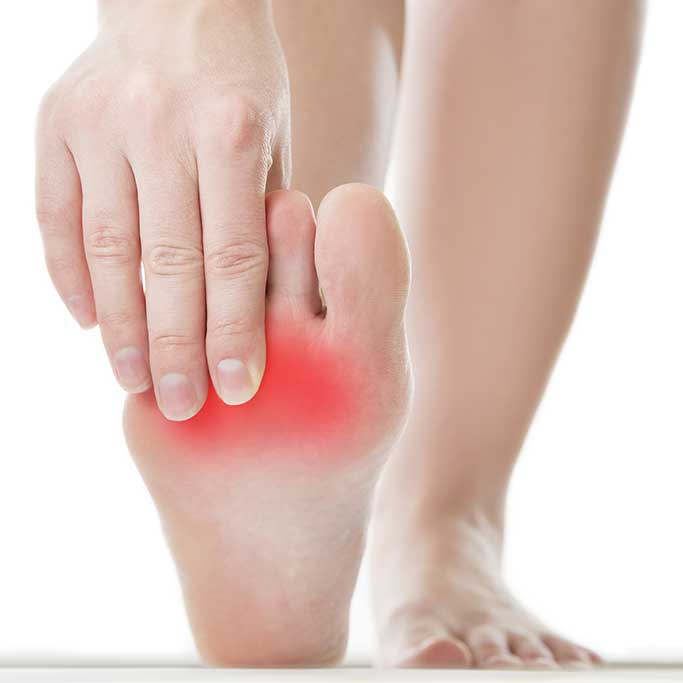 A painful condition like Morton’s neuroma affects the area that attaches the toes to the foot. This area is also referred to as the “ball of the foot”). Typically, it is between the third and fourth toes where Morton’s neuroma occurs.
A painful condition like Morton’s neuroma affects the area that attaches the toes to the foot. This area is also referred to as the “ball of the foot”). Typically, it is between the third and fourth toes where Morton’s neuroma occurs.
Every nerve that leads to the toes is surrounded by nerve tissue. When such a tissue thickens, it compresses (or squeezes) the nerve and causes a sharp, burning sensation in the ball of the foot. You may either have numbness or a burning sensation in the affected toes.
Wearing tight, narrow footwear has been known to aggravate Morton’s neuroma. The toe bones get compressed, pinching the nerve. But wearing high-heeled shoes seems to be the leading cause since this condition affects more women than men.
Whilst there are no outward signs of Morton’s neuroma, you may experience certain symptoms such as:
- Persistent shooting pain or burning in the ball of the foot especially when walking or running.
- The feeling of stepping on a pebble or marble when walking.
- Pain that occurs at the base between the third and fourth toes. In some cases, it can occur between the third and second toes.
- There may be unpleasant tingling or numbness in the affected toes.
Treatment for Morton’s neuroma includes:
- Wearing roomy shoes
- Using custom orthotics
- Getting cortisone injections
- Taking commonly prescribed medications
10.Kidney Disease
Burning feet is also one of the complications of kidneys that have stopped functioning properly. Kidney failure causes the build-up of toxins in the blood. Around 10% of patients with kidney disease have tenderness and swelling in the lower legs, not to mention the sensation of burning feet.
Dialysis is a common treatment for kidney diseases. However, it involves removing waste products and excess fluids from your body.
Consequently, dialysis also removes vitamin B1 (thiamine) from the blood. As a result, a patient may experience pain and burning in the feet due to nutritional deficiencies.
Even so, such a case is rare since dialysis patients receive vitamin B1 supplements during treatment.
Common complications of kidney failure include:
- Headaches
- Swelling
- Itching
- Weakness & numbness
- Confusion
- Fatigue and sleep problems and
- Joint pain
11.Complex Regional Pain Syndrome
Complex regional pain syndrome (CRPS) is a rare disorder that brings severe pain in a limb. More often than not, an injury or surgery can trigger this disorder, which involves damage to the nerves of the brain and spine.
The symptoms of complex regional pain syndrome include:
- Swelling
- Tingling
- Burning pain
- Changes in skin colour or texture
- Hypersensitivity to a pain trigger
Whilst injury or surgery has caused over 90% of CRPS cases, such a disorder is rare, which suggests that genetic factors could also be involved.
12.Erythromelalgia
Erythromelalgia (or Erythermalgia) is a condition that can be mistaken for CRPS since it also presents redness of the skin and intense burning pain. It is a rare condition that can make walking, sleeping and other tasks challenging.
Erythromelalgia is also a chronic condition, which means it stays with the affected person for life. Additionally, the symptoms of a burning sensation may worsen over time.
Erythromelalgia typically affects the feet but it may occur on the:
- Face
- Hands
- Arms and
- Legs
The underlying cause of Erythromelalgia is still unknown. But it is thought to have something to do with a certain dysfunction in the blood vessels that causes abnormal blood flow to the extremities.
The main symptoms of Erythromelalgia include:
- Skin redness
- Increase in skin temperature
- Mild tingling to severe pain
13.Hypothyroidism
Hypothyroidism is a common disorder of the endocrine system that may induce neurological disorders in the early stage of the disease. Also referred to as underactive thyroid, Hypothyroidism is a condition where the thyroid gland is not producing enough thyroid hormone to be released into the bloodstream.
Nerve damage is one of the symptoms of an underactive thyroid, which may also include burning feet syndrome. According to a study, peripheral neuropathy is more likely an early symptom of Hypothyroidism.
An underactive thyroid can slow down your metabolism. As a result, you always feel tired, you’ll gain weight and are unable to tolerate cold temperatures.
14.Peripheral Artery Disease
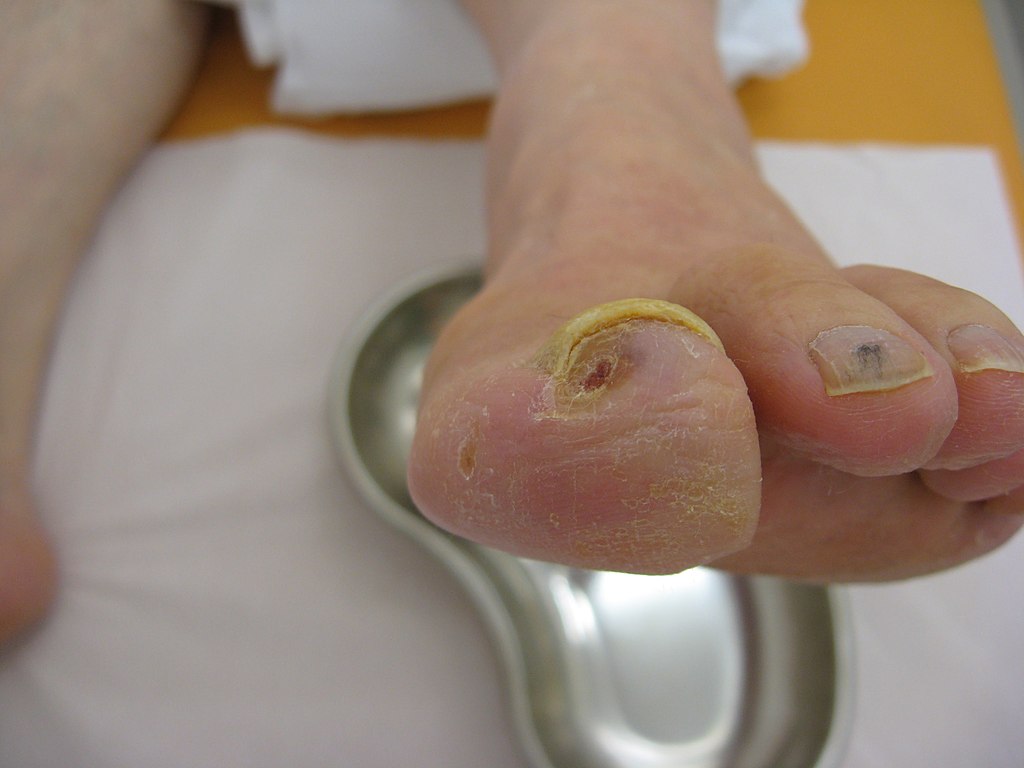 PerPeripheral Artery Disease: Wikimedia
PerPeripheral Artery Disease: Wikimedia
Peripheral Artery Disease (PAD) is a disorder involving the blood vessels that run from the heart to the legs. PAD is the narrowing of the artery or blood vessel walls as a result of plaque build-up. This type of peripheral neuropathy causes foot pain that is often triggered by walking or exercising.
The narrowing or blocking of blood flow deprives the lower limbs of oxygen, resulting in pain and burning sensation in the feet. Symptoms of PAD typically appear during walking or exercise and may go away after a few minutes of rest. The symptoms of PAD are:
- Pain
- Fatigue
- Achiness
- Burning sensation or
- Discomfort in the muscles of the lower limbs
How is the burning sensation in the feet diagnosed?
When you have burning sensations in the feet, it is best to see your doctor to prevent further nerve damage. Your doctor will perform a physical exam to indicate that you have:
- Reflexes
- Skin changes
- Fungal infection
- Lack of sensation
- Structural problems in your lower limbs
Also, you will be asked about your medical history, which may include any pain medications you’re taking and about the symptoms you’re experiencing.
You might also undergo blood tests for:
- Vitamin deficiency
- Kidney function
- Thyroid hormone
- HIV and other infections
- Imaging tests for symptoms of tarsal tunnel syndrome
How is burning feet syndrome treated?
Treatment for burning feet will depend on the underlying cause of the patient’s medical conditions.
Certain treatments can be straightforward. For instance, your doctor may prescribe antifungal products if you have an athlete’s foot.
Podiatrists may recommend remedies such as:
- Wearing comfortable shoes
- Using shoe inserts
- Taking thyroid supplements and Vitamin B supplements
For diabetic neuropathy, a change in your diet may be required. Certain drugs may also be prescribed to alleviate nerve pain. A study suggests that electrical nerve stimulation can be an effective alternative treatment for patients with diabetic peripheral neuropathy.
Home remedies:
- Applying topical creams, particularly those that contain lidocaine, a medicine that blocks pain signals at the skin’s nerve endings.
- Soaking your feet in cool water for a few minutes can provide temporary relief. Avoid using cold water. Also, it is not recommended if you have erythromelalgia because it may damage the skin.
- Alternatively, you can soak your feet in either an apple cider or Epsom salt solution. People with diabetes should consult their doctor before trying this remedy.
- Taking Curcumin or Turmeric supplements. The antioxidant and anti-inflammatory properties of Curcumin may help alleviate nerve pain.
Worried About Burning Feet Syndrome? We Can Help
The best way to manage the pain and burning in feet at night is to undergo a proper diagnosis of the cause. At Adelaide Foot & Ankle, our podiatrists carry out thorough assessments to determine the cause of the burning feet sensation you’re experiencing. We apply evidence-based procedures from the first-class services we have available.
We have helped residents in the inner north and northwestern parts of Adelaide, and we’d love to help you too. Request an appointment today!

